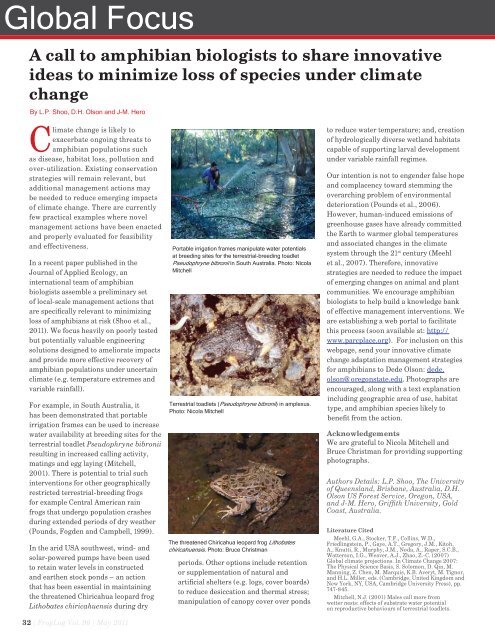download the FrogLog 96 - Amphibian Specialist Group
download the FrogLog 96 - Amphibian Specialist Group
download the FrogLog 96 - Amphibian Specialist Group
Create successful ePaper yourself
Turn your PDF publications into a flip-book with our unique Google optimized e-Paper software.
Global Focus<br />
A call to amphibian biologists to share innovative<br />
ideas to minimize loss of species under climate<br />
change<br />
By L.P. Shoo, D.H. Olson and J-M. Hero<br />
Climate change is likely to<br />
exacerbate ongoing threats to<br />
amphibian populations such<br />
as disease, habitat loss, pollution and<br />
over-utilization. Existing conservation<br />
strategies will remain relevant, but<br />
additional management actions may<br />
be needed to reduce emerging impacts<br />
of climate change. There are currently<br />
few practical examples where novel<br />
management actions have been enacted<br />
and properly evaluated for feasibility<br />
and effectiveness.<br />
In a recent paper published in <strong>the</strong><br />
Journal of Applied Ecology, an<br />
international team of amphibian<br />
biologists assemble a preliminary set<br />
of local-scale management actions that<br />
are specifically relevant to minimizing<br />
loss of amphibians at risk (Shoo et al.,<br />
2011). We focus heavily on poorly tested<br />
but potentially valuable engineering<br />
solutions designed to ameliorate impacts<br />
and provide more effective recovery of<br />
amphibian populations under uncertain<br />
climate (e.g. temperature extremes and<br />
variable rainfall).<br />
For example, in South Australia, it<br />
has been demonstrated that portable<br />
irrigation frames can be used to increase<br />
water availability at breeding sites for <strong>the</strong><br />
terrestrial toadlet Pseudophryne bibronii<br />
resulting in increased calling activity,<br />
matings and egg laying (Mitchell,<br />
2001). There is potential to trial such<br />
interventions for o<strong>the</strong>r geographically<br />
restricted terrestrial-breeding frogs<br />
for example Central American rain<br />
frogs that undergo population crashes<br />
during extended periods of dry wea<strong>the</strong>r<br />
(Pounds, Fogden and Campbell, 1999).<br />
In <strong>the</strong> arid USA southwest, wind- and<br />
solar-powered pumps have been used<br />
to retain water levels in constructed<br />
and ear<strong>the</strong>n stock ponds – an action<br />
that has been essential in maintaining<br />
<strong>the</strong> threatened Chiricahua leopard frog<br />
Lithobates chiricahuensis during dry<br />
32 | <strong>FrogLog</strong> Vol. <strong>96</strong> | May 2011<br />
Portable irrigation frames manipulate water potentials<br />
at breeding sites for <strong>the</strong> terrestrial-breeding toadlet<br />
Pseudophryne bibronii in South Australia. Photo: Nicola<br />
Mitchell<br />
Terrestrial toadlets (Pseudophryne bibronii) in amplexus.<br />
Photo: Nicola Mitchell<br />
The threatened Chiricahua leopard frog Lithobates<br />
chiricahuensis. Photo: Bruce Christman<br />
periods. O<strong>the</strong>r options include retention<br />
or supplementation of natural and<br />
artificial shelters (e.g. logs, cover boards)<br />
to reduce desiccation and <strong>the</strong>rmal stress;<br />
manipulation of canopy cover over ponds<br />
to reduce water temperature; and, creation<br />
of hydrologically diverse wetland habitats<br />
capable of supporting larval development<br />
under variable rainfall regimes.<br />
Our intention is not to engender false hope<br />
and complacency toward stemming <strong>the</strong><br />
overarching problem of environmental<br />
deterioration (Pounds et al., 2006).<br />
However, human-induced emissions of<br />
greenhouse gases have already committed<br />
<strong>the</strong> Earth to warmer global temperatures<br />
and associated changes in <strong>the</strong> climate<br />
system through <strong>the</strong> 21 st century (Meehl<br />
et al., 2007). Therefore, innovative<br />
strategies are needed to reduce <strong>the</strong> impact<br />
of emerging changes on animal and plant<br />
communities. We encourage amphibian<br />
biologists to help build a knowledge bank<br />
of effective management interventions. We<br />
are establishing a web portal to facilitate<br />
this process (soon available at: http://<br />
www.parcplace.org). For inclusion on this<br />
webpage, send your innovative climate<br />
change adaptation management strategies<br />
for amphibians to Dede Olson: dede.<br />
olson@oregonstate.edu. Photographs are<br />
encouraged, along with a text explanation<br />
including geographic area of use, habitat<br />
type, and amphibian species likely to<br />
benefit from <strong>the</strong> action.<br />
Acknowledgements<br />
We are grateful to Nicola Mitchell and<br />
Bruce Christman for providing supporting<br />
photographs.<br />
Authors Details: L.P. Shoo, The University<br />
of Queensland, Brisbane, Australia, D.H.<br />
Olson US Forest Service, Oregon, USA,<br />
and J-M. Hero, Griffith University, Gold<br />
Coast, Australia.<br />
Literature Cited<br />
Meehl, G.A., Stocker, T.F., Collins, W.D.,<br />
Friedlingstein, P., Gaye, A.T., Gregory, J.M., Kitoh,<br />
A., Knutti, R., Murphy, J.M., Noda, A., Raper, S.C.B.,<br />
Watterson, I.G., Weaver, A.J., Zhao, Z.-C. (2007)<br />
Global climate projections. In Climate Change 2007:<br />
The Physical Science Basis, S. Solomon, D. Qin, M.<br />
Manning, Z. Chen, M. Marquis, K.B. Averyt, M. Tignor,<br />
and H.L. Miller, eds. (Cambridge, United Kingdom and<br />
New York, NY, USA, Cambridge University Press), pp.<br />
747-845.<br />
Mitchell, N.J. (2001) Males call more from<br />
wetter nests: effects of substrate water potential<br />
on reproductive behaviours of terrestrial toadlets.
















